Site BAY
ALASKA
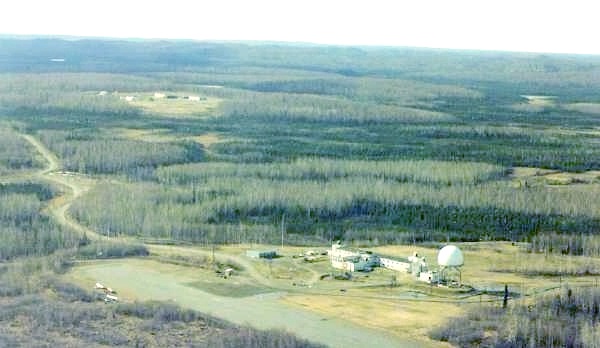

Charlie Battery
of the
Last Operational U.S. Nike-Hercules Missile Battalion
Updated 17 August, 2008


Updated 17 August, 2008

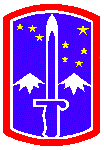
...was one of three Nike-Hercules missile firing batteries that were the last to provide a defensive ring of fire around a North American area defense during the Cold War.
This webpage is an attempt to preserve some memory of the place and time that is rapidly disappearing. If you stumbled across this webpage by means other than the link from the NIKE-HERCULES ALASKA INDEX page, you may wish to go there first for a little background information before proceeding. Please CLICK HERE to do so, then follow the link back. Thank you.
C Battery was stationed at Site Bay. The aerial photograph at the top of this webpage faces roughly southwest and shows the site as it appeared in the early 1970's. The IFC (Integrated Fire Control) area with its radar domes and airstrip is in the foreground and the launcher area in the background. This next photograph below taken a few years later shows the opposite view with the launcher area in the foreground and the IFC behind. Cook inlet and the base of the mountains to the east is visible beyond that. One of the launcher buildings in the foreground has two missiles up.
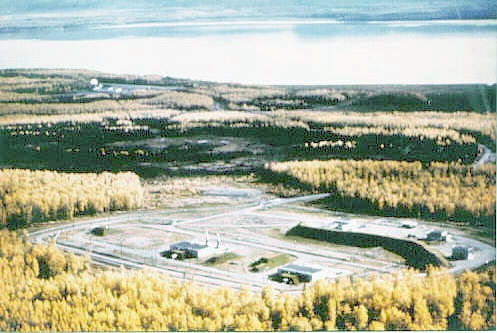
This next photo faces the same direction but is taken from ground level just outside the launcher area fence. Note the mountains across the bay and the IFC area at upper left. In my mind this photograph captures all the unique features of the Alaskan Nike sites. Many thanks to the contributor, a site Bay veteran, who provided most of the photographs on this webpage to date.

Like all Alaska Nike sites, Bay served not only as duty station but as a "home away from home" for hundreds of servicemen over the twenty years of its operation. Hopefully the paragraphs in the sections below will convey some of the flavor of life at site Bay. Here are a few photos to orient the reader's inner eye:
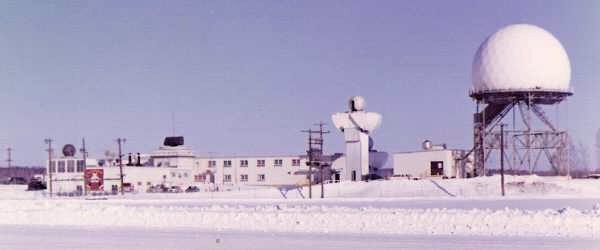
Most of the missile sites had mascots from time to time. One of these from the 1973 timeframe was named "Heidi". The picture on the left is of artwork painted on the engineering section of the IFC.
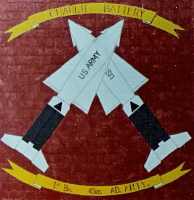
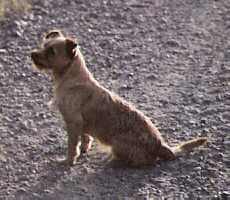
This view shows the front of one of the launcher buildings - "B" section.
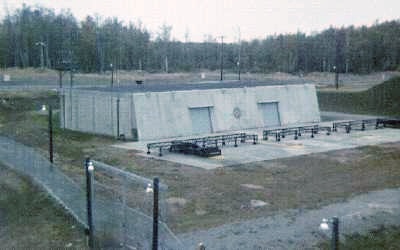
Here is a "practice round" for missile assembly training.
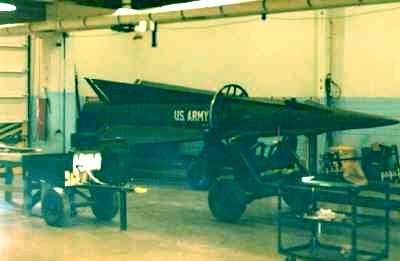
And this is what it's all about:
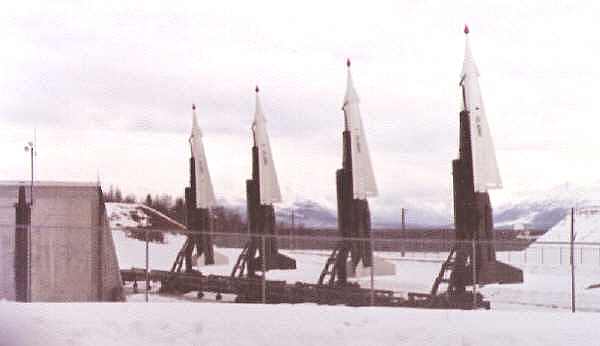
The photograph below was taken from Anchorage facing northwest across the inlet. The white "golf ball" of C-battery's HIPAR (High Powered Acquisition Radar) can be seen as a white spot at center.
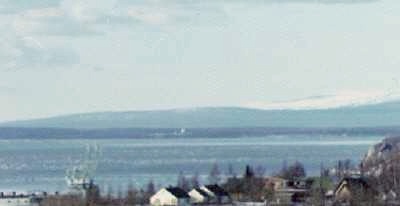
Although site Bay was only a short hop to the northwest across the Knik arm of Cook inlet from the Anchorage/Fort Richardson/Elmendorf AFB complex, it was a long, rough (90 miles?) drive for those that needed to commute. For that reason, helicopters and Otter aircraft were provided for that purpose.

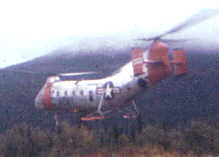
CLICK HERE to visit a page about the 12th Aviation Company that operated these aircraft.
An officer stationed there in the early 1960's notes: "We went to work by helicopter, the H-21 [Shawnee]. "The pilots always chose their path based on needing an open area in case of power failure and a need to make an emergency landing. One evening, during crew change, the wind picked up and the helicopter was having trouble making any headway against the wind coming up Cook Inlet. As chance would have it, the chopper lost power. We came down just short of an open area. Lots of toothpicks. The chopper ruined. All of our crew escaped unharmed, but the pilots were in the hospital for a few weeks. Everyone recovered fully. That is, all but the chopper."
A contributor stationed there in the early 1970's states: "The last of the draftee's got out towards the end of my enlistment and career guys were referred to as "lifers". The lifers living on Fort Rich would arrive by Otter or chopper begining around 6:30am and any who had been on duty overnight would return to the fort on those same morning choppers. As the first chopper made it's way over in the morning, the battery would echo to the call (warning?) "LIFERS!!!""
The view on the right below shows some of the men from Ft. Richardson catching the chopper home around 3:30 pm.
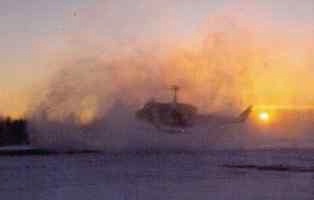

Sometime prior to 1978 the regular flights between Fort Richardson and Charlie battery had ceased and were replaced by a shuttle bus runner twice per day.
Selected quotes from corespondence with one contributor:
"Bay was pretty isolated and our life revolved around the few neighbors, all homesteaders. Our launcher platoon sergeant was even a homesteader and some of the crating materials from the original site construction went into the construction of his homesteader cabin.
"Sundays at the site was the highlight of the week for the homesteaders and us. The Battalion Chaplain came out by chopper and we always had homesteader visitors for church service. They would remain for lunch, then we'd pull down the blinds in the mess hall and show all the week's movies.
"The site served as a meeting place for the local homesteaders. They shared their socials with off-duty troops. There was an annual meeting with a representative from the Office of the Bureau of Land Management regarding whether each homesteader had accomplished the required annual improvements on his homestead; whether the homesteader had 'proven up' satisfactorily for the year. I noticed an argument between the inspector and a homesteader so I sidled over to hear what was going on. It seemed that the homesteader had popped the ultimate question. "Why do I need an outhouse when I've got 160 acres of trees?""
"Bush pilots came and went every day or so. I was able to recognize many of them after awhile. Off-duty troops availed themselves of the air transportation to hunting and fishing trips. One week, a couple of fellows weren't available for scheduled duty. There was no record of them going by chopper to Ft Richardson. Someone mentioned that he recalled hearing of a planned fishing outing. Our next job was to find the bush pilot who may have taken them. Sure enough, after awhile, one of the bush pilots acknowledged that he had forgotten to go back after the troops. A sign-out process was instituted after that.
"Hunting and fishing were the main off-duty entertainment. Site Bay was also a hunting and fishing retreat for the USARAL and ALCOM senior leaders. We had freezers to keep their catches and we had smokers that were always filled with salmon. Our motor sergeant was one who was always concerned for protocol and he could not tolerate our lack of assigned vehicles appropriate to the transport of senior officers. So Motor Sergeant and a couple of mechanics went to the Ft Richardson salvage and brought back a retired military sedan. When the generals landed in their helicopters, one of our guys met them in the sedan (decked out with the appropriate red or blue plate with stars). It was hard to hold back a laugh, but that's the way it was at Site Bay."
"The guys assigned to the other sites could never figure out how we constantly maxed out the operational readiness inspections. Didn't matter what was the subject of inspection. We always maxed. There were several little secrets at work. 1) We knew that immediately prior to opening of hunting or fishing season we would have a major inspection. Upon conclusion of the inspection, the hunting or fishing trip got underway. 2) There were only 2 ways an inspection team could travel to Site Bay - either by air or by land. Of course, it cost us a little bit of booty (e.g., some smoked salmon), but we got good information from Flight Operations at Ft Richardson or the only restaurant within the final hour's drive from Palmer and Wasilla. ...[which was] the restaurant everybody always stopped at when driving out to the site. They made the largest, and greasiest, donuts and the largest cups of coffee. One donut was a meal. They were soooooo good! Just coffee and donut. It didn't take much booty on our part to get advanced warning when the inspection team arrived at the restaurant. All the regulars were known to the restaurant owner. Anyone not known, but in uniform and in military vehicle, was a suspect inspector. There was only one place military folks were headed when they stopped at the restaurant - Site Bay Nike site - an hour's drive down the gravel road. We always had sufficient time to "dispatch" all the vehicles from the motor pool or to make final corrections to a missile component."
"One night, we had a surprise security inspection by the new Battalion Security Officer. I met him, scroungy looking in camouflage gear, as he was hanging from the fence and one of the sentry dogs "Sugar" was just hoping he would fall and was trying to encourage the Captain to drop from the fence. The new security officer wasn't playing fair, but we passed the inspection. Sort of like, "Let's make a deal." before we backed off the sentry dog."
The following was contributed by the man who was the executive officer of C battery at the time:
"One night after pulling midnight checks in October of 1962 we got the command to come to "Battle Stations" from the Fire Island AADCP. We had not gotten any Intelligence build up or other information that would have indicated a threat or reason to go to Battle Stations. Surely they meant we were to have an operational inspection of some sort and "Blazing Skies" was the correct command. I went through the crypto key process and challenged the AADCP because we were the "hot" battery (i.e. 5 minute status) for Anchorage/Elmendorf [that week] so it was critical that the control center get things right.
"Meanwhile, I had initiated all the "Battle Stations" procedures including elevating the missiles with everything hot and ready to fire, troops up and outfitted for combat, stringing barbed wire, digging foxholes outside the fences, sentry dog teams deployed, etc. Our launcher warrant called me on the intercom and said that all the launchers were loaded, hooked up, gyros running, and pointed towards the sky and asked me in which order I would like for him to fire them. Not very funny!
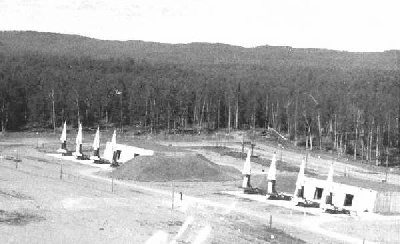
"I kept challenging with the authentication keys hoping that Fire Island would finally acknowledge that it was really "Blazing Skies" but it wasn't to be. It was "Battle Stations!" And no one up the NORAD chain knew what was going on - but everybody was scrambling.
"Several hours went by. Radars searching the horizon. What were we looking for? When it was approaching daylight in Alaska president Kennedy made an announcement to the world that Cuba had been surrounded and was blockaded. "Pucker factor" maxed out! Cuban Missile Crisis underway.
"We remained at Battle Stations for the next month, rotating with the other batteries in order to pull necessary periodic checks. The foxholes became very livable."
"Although alot of the names elude me, I have a vivid memory of the site and the many faces that occupied it while I was there, like the old civilian contractor who we called 'Grumpy'; he would drive the road grader to plow Homesteaders Road so we could get downrange in the winter. I can remember [a fellow MP] having a burgundy 1964 Galaxie that we would spin out on the airstrip in the winter, usually after a couple of bottles of Boones Farm from the Knik Bar. I had a 1970 Polara, and we would race the airstrip in the winter, spinning into the woods on occasion."
"We would go to the Knik Bar when the Iditarod Trail race was running, to see the teams and the race. It was a checkpoint at the time. The teams would start in Anchorage and run up into the Matanuska-Susitna valley for the first stage, load up, and restart at the inlet by the bar if there was not enough snow to get across the valley to Wasilla."
"Lake trout fishing behind the downrange area was always fun, except when a radar techie and I broke into the mess hall one Sunday to cook our catch because the gas in his camper had run out. We got caught by the duty officer (who was also the company commander) and our punishment was one week of KP, cook him lunch, and we had to fork over 1/2 of our catch!"
"Many a long night was spent downrange staying up all night playing Pinochle and Crazy 8's and finishing off a 30 cup coffee pot while we waited our turn in the guard towers. I never could sleep on the metal bunk beds! Of course, taking part in the NAICP drills while on the SAT and BAF teams, and sitting for hours in the snow on the top of that berm was never fun; but all in all I had a great time."
Each Alaskan firing battery would fire annual practice missiles from sites near home. The Anchorage area batterys would fire from site Summit, home of B battery on a mountaintop east of Anchorage. This photo of a launch from site Summit was contributed by an officer of site Point (A battery) that captured it during practice firings in November of 1961.
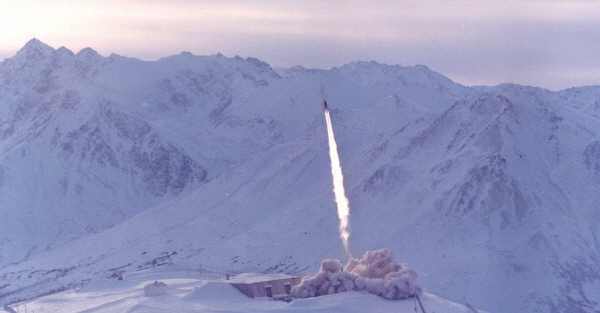
By early 1964 the growing population surrounding the Anchorage area forced the 43rd ADA's fire units to make their practice shots from the Fairbanks area's missile sites (2nd Bn, 562nd Artillery). After the Fairbanks sites were deactivated in 1970 and 1971, the Anchorage batterys were required to travel to Fort Bliss Texas to fire from the McGregor Range facility. The following series of photographs show soldiers of C battery engaged in a qualification drill at McGregor Range circa 1973. The first image shows missile components in prep impoundment ready to be assembled:
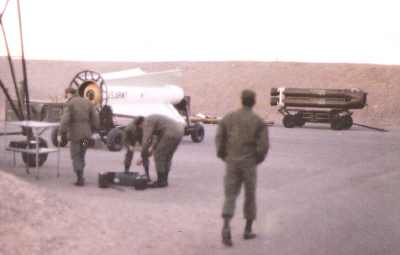
The finished round on its transport trailer:
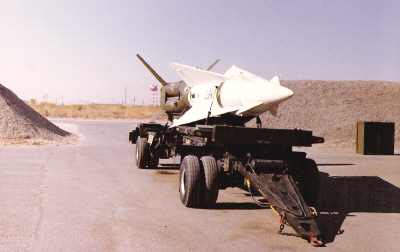
A truck pulling the trailer into the rail loading station:
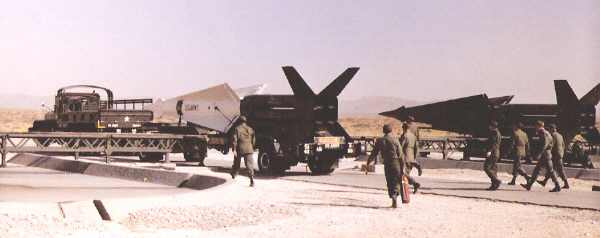
The crew pushing the round from the trailer onto the rails:
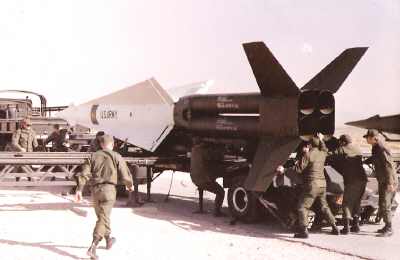
The missile being raised on the launcher...
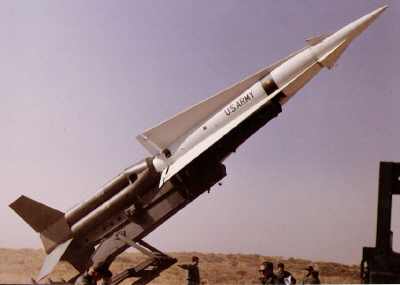
...and a very distant shot of it's launch.
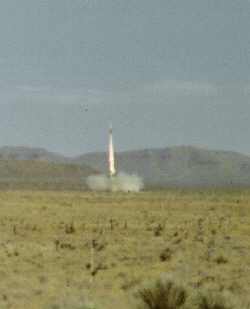
Here is a photo of another launch from the same era (1973):
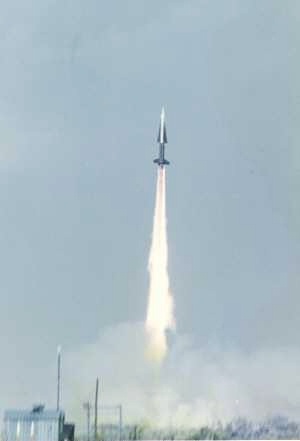
By 1972 rumors of deactivation were floating around the battalion, and these continued until the reality occured in 1979. The military/political situation of the Cold War had changed to the point that the cost of maintaining the battalion was no longer justified by NORAD's defensive requirements.
The 1/43 ADA, the last remaining Nike-Hercules battalion sited in North America stood down in April and was deactived at Fort Richardson on 30 July 1979, thereby closing a colorful chapter in the history of the Cold War that was to continue another ten years.
Links to photographs of the site taken as recently as 2003 can be found on the NIKE ALASKA INDEX page..
A recent contributor notes: "I ran across a couple that live out by Goose Bay now and they told me that following deactivation the Bay Site buildings housed some sort of correctional facility for a short time. Kind of fitting I thought! Afterwards the complex was razed although they seemed to think a couple of the storage bunkers between the IFC and Launch area were still standing. I guess the area is a hotbed of real estate development nowadays and there is talk of building a deep water port in the vicinity."
Note 31 October, 2005: According to a newspaper article (in the Frontiersman?) the final destruction of the buildings at C-battery - even the fences - was accomplished in October, 2005 and the remains taken to recycling facilities. Total erasure of the site, including recontouring and reseeding of the land is scheduled for the spring of 2006.
The photo below of a site Bay launcher building was taken in September, 2006:
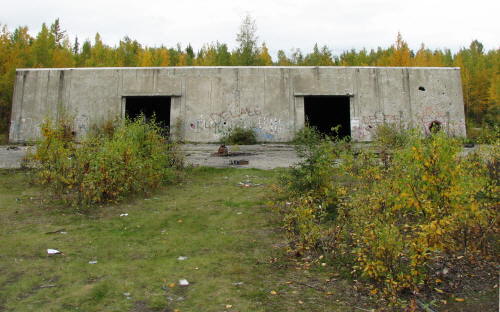
Note 03 August, 2008: Another contributor notes: "Here's the current condition of the Site. The IFC area is completely gone but the bunkers, warhead assembly and fuel bunkers are still there. Basically anything made of reinforced concrete was evidently too much expense and/or hassle to remove."
- Juliet Tango Sierra, December, 2004


